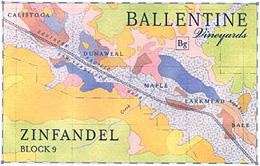

Ballentine Vineyards
2002 Zinfandel Block 9 Reserve, Pocai Vineyard(Napa Valley)
It’s a good thing Van Ballentine married Betty Pocai. Otherwise, they might not have made such a wonderful Zinfandel from the nearly 100-year-old Calistoga vineyard that Betty’s granddad, Libero Pocai, bought in 1905. It’s also a good thing that Bruce Devlin was promoted to winemaker in 2002, otherwise, one of his first wines for Ballentine might not have turned out the way it did.
What we have here is a wine with lots o’ menthol aromas, which mostly dissipate, only to reveal a wine with perfect pitch, in spite of the listed high alcohol percentage of 14.9. I suggest holding onto it for a couple of years to allow it to settle down, and then drink it over the ensuing 15 years.
The Pocai Vineyard is located on the valley floor, between Maple Lane and the Silverado Trail near Calistoga, just west of Dutch Henry Winery. The soil is called "Bg," for Bale gravelly loam. Yields are small, about three tons per acre. Only 700 cases were produced. The wine was aged for 17 months in 35 percent new American and 10 percent new French oak.
Reviewed March 21, 2007 by Alan Goldfarb.
The Wine
Winery: Ballentine Vineyards |
The Reviewer Alan Goldfarb
Alan Goldfarb
Alan Goldfarb has been writing about and reviewing wine for 17 years. His reviews have been published in the St. Helena Star, San Jose Mercury, San Francisco Examiner, Decanter, and Wine Enthusiast, among others. Not once has he used a point system, star system, or an iconic symbol to quantify a wine. What counts in Mr. Goldfarb’s criteria when judging a wine is: how it tastes in the glass; is it well-constructed; its food compatibility; and presence of redeeming regional attributes. |










